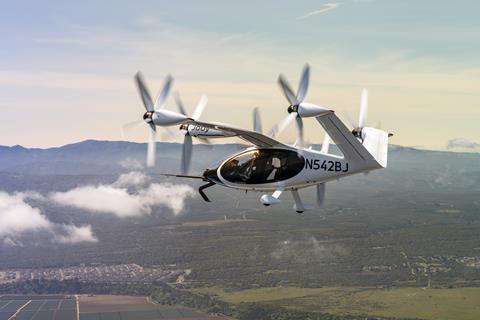Air taxi start-up Joby Aviation has gained regulatory clearance to deploy a suite of in-house software products designed to manage future air taxi operations and to enable the type of high-frequency, on-demand flights the company envisions.
Permission to use the ElevateOS system was granted by the US Federal Aviation Administration (FAA) has now been received, California-based Joby said on 20 June.
“ElevateOS is the result of many years of iteration and real-life experience, and we’re confident it is the most sophisticated, efficient and flexible suite of air-operations tools available today,” says Joby chief product officer Eric Allison.

The company has been quietly developing and testing the software while also pressing ahead with its single-pilot, four-passenger electric vertical take-off and landing air taxi.
Joby aims to have its aircraft, the S4-1, in service next year, though its ability to hit that goal remains unclear due to uncertainty about the pace of FAA approval.
The company plans to operate air taxis under FAA Part 135 rules, which apply to charter operators, and envisions an Uber-like operating model with passengers using smartphone apps to hail rides.
Joby operations president Bonny Simi describes ElevateOS as the foundation to such an operation – a key as critical to the vision as the air taxi itself.
ElevateOS encompasses various operational and scheduling functions, and includes pilot tools and a ride-hailing app that accepts payments. Joby has already tested the app with employees who used the system to book seats on the company’s Cirrus SR-22.
Joby designed the software in-house because existing airline operations software is tailed for carriers operating scheduled flights, making such systems ill-suited for on-demand operations.
“There is literally no way you could operate a high-pace, on-demand air-taxi operation with any software that is out there,” Simi says.

Allison says Joby developed the software in part with resources acquired through its 2021 acquisition of Uber’s air taxi division Elevate. He notes Elevate had developed an aircraft-hailing app that it tested in New York using helicopter flights.
Separately, Joby says it has developed a pilot training course that could allow existing commercial pilots to qualify to fly Joby’s aircraft within six weeks. It is working with Canadian flight-training company CAE to develop required full-motion, six-axis simulators.
Despite talk of a broad pilot shortage, Joby believes enough pilots will be available to support its initial operations, says Simi.
To ensure a longer-term new-pilot supply, Joby is working to achieve certification from the FAA for a Part 141 flight school. Simi says such a school would allow Joby to train new student pilots, bringing them through the 500h of flight time required to operate its aircraft.
Much remains unclear about FAA requirements for air taxi pilots, but last year the agency proposed that pilots be required to hold type ratings specific to air taxi models.
The air taxi sector has railing against that plan, because it would necessitate, under current rules, that pilots be trained in aircraft that have two sets of controls. Most in-development air taxis are single-pilot machines.


























